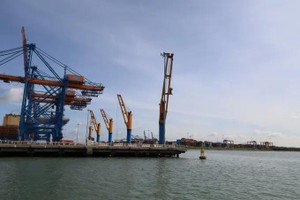 |
In highly developed countries, the private sector accounts for more than 85 percent of the GDP. A national economy needs the support of a strong and stable private sector, which in recent days is showing profound signs of losing momentum across Vietnam.
Inadequate policies
According to data from the General Statistics Office under the Ministry of Planning and Investment, in the first quarter, more than 20,000 businesses withdrew from the market across the country. This is also the first time that such a high number of enterprises have withdrawn from the market as compared to the number of enterprises entering the market. Not only are the numbers increasing but also the capital registration level of enterprises is seeing a sharp decline. About 12 out of 17 sectors saw a decrease in registered capital, including in key industries such as transportation, warehousing, finance, banking, insurance, and real estate.
Commenting on this issue, Dr. Nguyen Minh Thao, Head of Research on Business Environment and Competitiveness at the Central Institute for Economic Management (CIEM), said that these figures are going against the trend and most worrisome. Because normally, newly established enterprises are always more in number than temporarily closed enterprises. It is unusual to see that in the first three months of this year the number of enterprises temporarily suspending operations is higher than the number of newly established enterprises. This indicates an increase of risks and challenges for production and business activities.
Talking about the fact that many businesses have had to suspend operations, Ms. Thao said that the institutional and policy factors are inadequacies and barriers that have led to a decrease in business confidence. This is one of the warning signs that policymakers need to be more cautious of and ensure more openness, transparency, clarity, and work towards reinforcing trust for businesses to operate unimpeded.
Dr. Nguyen Minh Thao emphasized that our legal background is not discriminatory, but in action, we always tend to pay more attention to solving problems of foreign enterprises in a timelier manner than for domestic ones. Hence, without paying attention to domestic enterprises, it will not be possible to strengthen internal resources. This is a lesson for ministries and local agencies to pay more attention to and listen more to solve specific problems of enterprises, especially domestic enterprises. Statistics show that Vietnam's private economic sector is less than 40 percent of the GDP, with more than 98 percent being SMEs, doing small and very small businesses.
Assessing the weakness of the private enterprise sector, Dr. Vu Tien Loc, who has been with the business community for more than 20 years, admitted frankly that enterprises are the result of institutions, but enterprises are also the driving force for institutional reforms. Hence the State must look at enterprises to know what to do and how to implement policies.
In fact, the productivity of private enterprises has shown signs of a decrease since early 2000. According to Dr. Le Duy Binh, Managing Director of Economica Vietnam, in terms of the Incremental Capital Output Ratio (ICOR), there is currently a trend of reversal between the state economic sector and the private economic sector. If in 2010, the state economic sector needed VND9.8 to generate VND1 of the GDP, the private economic sector only needed VND4.3 to generate VND1 of the GDP. However, now this trend is reversing. While the state economic sector still maintains a capital of VND10 for VND1 of the GDP, the private economic sector needs VND23 to generate VND1 of the GDP.
Besides subjective reasons such as the Covid-19 pandemic, a volatile market, a broken supply chain caused by the Russia-Ukraine war, and various global trade wars, it is impossible not to talk about the internal private enterprise sector that is having problems. This is the internal instability of private enterprises which has been revealed through the precariousness of private enterprises in real estate and securities in recent years. These sectors occupy the most capital of the economy but are also the main causes of instability for the economy. Many large enterprises fell into difficulties and crises, and some were even on the verge of collapse. This situation inevitably caused the public to ask questions about the state of the economy and the private enterprise sector.
According to Mr. Phạm Chi Lan, an economist, one of the reasons why the private sector in general and private enterprises, in particular, develop sluggishly and distortedly is due to inadequate management. As a result, a new section of private enterprises was born. In the past, there were corporations that operated inefficiently but were sponsored by interest groups. There have been many people who have made great careers and even broke the law, but due to close relationships with interest groups, the matters were overlooked for many years.
The difference here is that in the past some businesses focused mainly on SOE models such as Vinashin or Vinalines, but now these businesses have expanded to the private sector. This group of private enterprises has strong relationships and enjoys privileges and benefits that other enterprises cannot obtain. More broadly speaking, this is also a type of distortion of interest groups. They not only distort the private sector but also cause much harm to the economy in the long term.
























